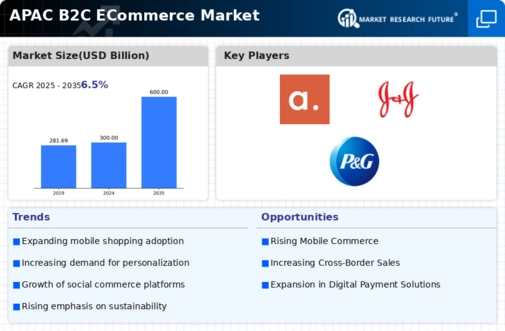Diverse Payment Options
The availability of diverse payment options significantly influences the Global APAC B2C ECommerce Market Industry. Consumers are increasingly seeking flexibility in payment methods, including digital wallets, bank transfers, and buy-now-pay-later services. Countries like Japan and South Korea are leading in adopting advanced payment technologies, which enhance consumer confidence and encourage online purchases. As the market evolves, businesses that offer multiple payment solutions are likely to attract a broader customer base. This trend is expected to support the industry's growth, with a projected market size of 300 USD Billion in 2024, reflecting the importance of accommodating consumer preferences.
Market Growth Projections
The Global APAC B2C ECommerce Market Industry is poised for substantial growth, with projections indicating a market size of 600 USD Billion by 2035. This growth is underpinned by a compound annual growth rate of 6.5% from 2025 to 2035, reflecting the increasing adoption of online shopping across the region. The expansion of digital payment solutions, coupled with the rising number of internet users, suggests a favorable environment for eCommerce businesses. As companies adapt to changing consumer preferences and invest in technology, the market is likely to witness sustained growth, positioning APAC as a leading player in the global eCommerce landscape.
Mobile Commerce Expansion
Mobile commerce is a pivotal driver in the Global APAC B2C ECommerce Market Industry, as consumers increasingly prefer shopping via smartphones and tablets. With mobile devices accounting for over 60% of online transactions in 2024, businesses are optimizing their platforms for mobile use. This trend is particularly evident in markets like China, where mobile payment solutions such as Alipay and WeChat Pay dominate. The convenience and accessibility offered by mobile commerce are likely to propel the market's growth, contributing to the anticipated increase to 600 USD Billion by 2035. The CAGR of 6.5% from 2025 to 2035 further underscores the potential of this segment.
Rising Internet Penetration
The Global APAC B2C ECommerce Market Industry experiences robust growth due to increasing internet penetration across the region. As of 2024, internet users in APAC are projected to exceed 2.5 billion, representing a significant portion of the population. This surge facilitates easier access to online shopping platforms, enabling consumers to explore a diverse range of products and services. Countries like India and Indonesia are witnessing rapid digital adoption, which is likely to drive the market further. The growing number of internet users is expected to contribute to the industry's valuation of 300 USD Billion in 2024, indicating a strong trajectory for future growth.
Growing Middle-Class Population
The expanding middle-class population in APAC is a crucial driver for the Global APAC B2C ECommerce Market Industry. As disposable incomes rise, more consumers are willing to spend on online shopping, leading to increased demand for various products and services. Countries such as Vietnam and the Philippines are experiencing rapid economic growth, resulting in a burgeoning middle class that seeks quality and convenience. This demographic shift is likely to propel the market's valuation to 600 USD Billion by 2035. The anticipated CAGR of 6.5% from 2025 to 2035 suggests that the middle-class expansion will continue to play a vital role in shaping the eCommerce landscape.
Enhanced Logistics and Supply Chain
Improvements in logistics and supply chain management are vital for the Global APAC B2C ECommerce Market Industry. Efficient delivery systems and warehousing solutions are essential for meeting consumer expectations regarding fast shipping and product availability. Countries like Singapore are investing heavily in logistics infrastructure, which enhances the overall shopping experience. The integration of technology in supply chain operations, such as real-time tracking and automated warehousing, is likely to streamline processes and reduce costs. This focus on logistics is expected to support the industry's growth trajectory, contributing to the projected market size of 300 USD Billion in 2024.














Leave a Comment